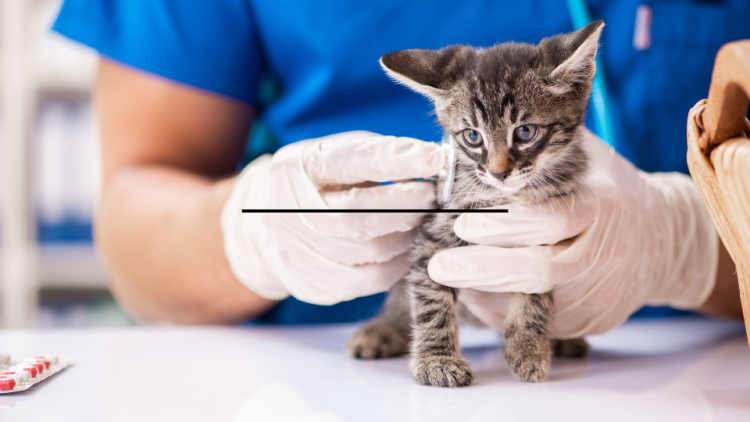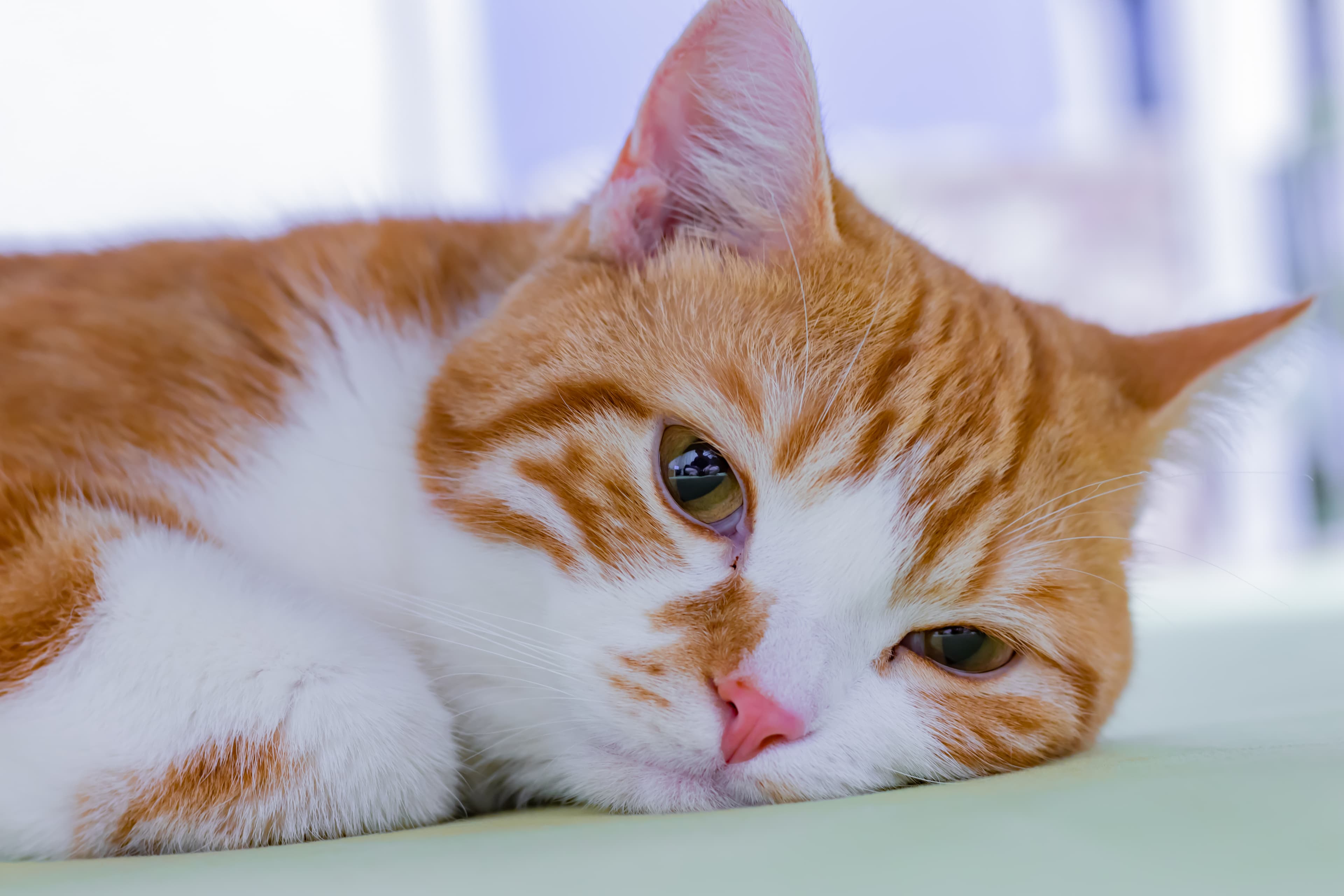Feline panleukopenia virus (abbreviated FP, FPL, or FPV) is highly contagious, incredibly resilient, and frequently fatal — especially in unvaccinated kittens. It can thrive on almost any surface and persist for long periods, contributing to such high infection rates.
The virus, which is also known as distemper in cats, may be slightly misleading because it’s actually caused by a feline parvovirus. Many people are aware of parvovirus in dogs (caused by a similar but distinct disease), though fewer people know that cats can get parvo, too.
In the article below, you’ll learn how to recognize the signs of feline panleukopenia virus in cats, which treatment options are available, and how to protect your pet from this life-threatening disease.
Table of Contents
- What is feline panleukopenia?
- What are the symptoms of FPV in cats?
- Which cats are at risk of distemper?
- How do cats get distemper?
- How do you test for feline panleukopenia?
- How do you treat FPV in cats?
- Can cats survive FPV?
- How to prevent feline panleukopenia
- FAQS on Feline Panleukopenia
What is feline panleukopenia?
Panleukopenia refers to a decreased number of white blood cells in the bloodstream. White blood cells play a significant role in the immune system and are essential in defense against infectious diseases. In severe cases of FP in cats, white blood cell counts can drop from the normal range of several thousand per milliliter of blood to merely a few hundred, rendering cats extremely susceptible to illness.
What are the symptoms of feline panleukopenia?
Our feline friends are remarkably good at concealing afflictions, so the first signs of distemper in cats might be difficult to detect, as they are generally less severe than those with late-stage infections.
Keep an eye out for the following clinical signs of FLPV and contact your vet right away should you notice any to ensure your pet gets the swift treatment they need for an increased chance of survival.
First signs of panleukopenia (distemper) in cats
The symptoms of early-onset panleukopenia in cats sick include:
- Watery discharge from the nose
- Lethargy
- Depression
- Fever
- Vomiting
- Weight loss
- Dehydration
- Diarrhea
- Rough coat
- Inability to eat and drink
- Painful or tense abdomen
Late-stage symptoms of panleukopenia (distemper) in cats
Some cats affected by the disease will experience a rapid progression to severe dehydration, sometimes vomiting with bloody diarrhea. Other late-stage symptoms may include bruising of the gums or skin and collapse. In addition, your pet's body temperature might fall to lower-than-normal levels. However, a cat with feline distemper may die suddenly without expressing any symptoms at all.**
Infected kittens exposed to the virus in the late stages of in-utero development might be born with cerebellar hypoplasia. This neurological disorder affects the area of the brain in charge of movement, balance, and coordination. Affected kittens will have a wide-based posture and mild to severe tremors. They can also appear uncoordinated or fall over regularly, but with close observation and care, panleukopenia kittens can nevertheless have fulfilling lives.
Which cats are at risk of distemper?
According to the AVMA, all cats can get parvo (which causes distemper), but kittens are the most susceptible due to their weakened immunity. Parvoviruses, including feline panleukopenia, are extremely resilient and can only be killed by strong chemical disinfectants.
It exists virtually everywhere in the environment, meaning both indoor cats and outdoor cats may become exposed at some point in their lives. In the right conditions, the feline panleukopenia virus can survive on surfaces for over a year or more.
How do cats get distemper?
A cat can get FPV by touching virus-carrying fluids (urine, feces, and nasal secretions) or even fleas from infected cats. Infected animals typically shed the virus for one or two days, but the virus can live for up to a year in the environment. This means that your cat may contract the virus without even coming into direct contact with an infected feline.
Cats may contract the virus through bedding, food bowls, cages, as well as the clothing or hands of people who come into contact with infected cats. For this reason, isolating sick cats is crucial in order to stop the virus from spreading.
When to quarantine cats exposed to feline panleukopenia?
According to Alex Ellis, DVM at the University of Wisconsin-Madison School of Veterinary Medicine, the likelihood of infection with feline panleukopenia is influenced by the cat’s individual immunological and immunization state. Completely immunized cats older than five months have a very low probability of getting sick (i.e., vaccinated at least three days prior to exposure, keeping in mind that shedding may occur up to three days before clinical signs become apparent).
Due to maternal antibody interference, the risk is higher in:
- Kittens under four months of age
- Cats vaccinated less than a week before exposure
- Cats vaccinated with a killed or intranasal vaccine
- Cats that were closely exposed but were unvaccinated
To stop the spread of distemper in cats, felines that are significantly exposed or at-risk must be separated from sick cats.
Can dogs get parvo from cats?
No. There are distinct, species-specific parvovirus strains for both dogs and cats.
Canines cannot contract the feline strain of the virus, known as feline panleukopenia virus (FPV), which poses a serious danger to the feline population.
Likewise, the specific virus responsible for parvo in puppies and dogs canines doesn’t infect cats, so your cat can't get feline parvo from dogs.
Is feline panleukopenia zoonotic?
Feline panleukopenia is not a zoonotic disease, meaning a person cannot get distemper from a cat. However, while the sickness is not contagious to people or dogs, ferrets can contract it from cats and vice versa.
How do you test for feline panleukopenia?
Feline panleukopenia can resemble various other diseases, including feline immunodeficiency virus (FeLV) and feline leukemia virus (FIV). Your veterinarian will probably perform blood tests to aid in the diagnosis. Blood tests that show severely reduced levels of white and red blood cells, combined with a history of exposure, lack of vaccination, and visible symptoms of illness, all point to feline panleukopenia.

A veterinarian can also conduct fecal testing to diagnose feline panleukopenia. However, this diagnostic test frequently yields false positive results in cats who received the vaccine five to 12 days earlier. Additional tests that diagnose distemper in cats include:
- Virus isolation (a test to locate the virus in various tissue samples)
- PCR testing
- Antibody level analysis
How do you treat FPV in cats?
There are no specific medications for feline panleukopenia. Intensive care and treatment are essential to maintain the cat’s health with drugs and fluids until its own immune system can fight off the virus. A cat with FP may pass away in up to 90% of cases without such supportive treatment.
Intravenous fluid therapy can help correct dehydration, while prescription drugs may address clinical symptoms of vomiting and diarrhea in cats. When white blood cell counts are low, antibiotic medication is frequently started to help manage any secondary bacterial infections. Acute therapy and nursing care, including plasma/blood transfusions and anticoagulant medications, are required for resuscitation in cats who have serious infections.
Having your cat in the veterinary hospital for treatment is stressful, especially since most felines with panleukopenia are young. Extended treatment and care in a veterinary hospital can be pretty costly, but luckily, pet insurance for cats can help ease the financial stress.
Can cats survive FPV?
Infected kittens younger than eight weeks old have a low chance of recovering from FP.
Most infected kittens that are born during the early to mid-pregnancy stages of infection do not survive. Depending on the severity of the neurological symptoms, those who contract the infection in the later stages of pregnancy often experience cerebellar hypoplasia but still live happy, healthy lives with normal survival rates.
If appropriate care is given promptly, older cats have a better chance of surviving. Cats with low body temperatures, low protein levels, thin bodies, and/or abnormally low white blood cell counts on blood tests have a worse prognosis and typically die within 12 to 24 hours.
How long does it take to recover from feline panleukopenia?
If your cat receives timely, efficient treatment and survives the first 48 hours, there is a good chance that they will fully recover. When a cat recovers from feline panleukopenia, their organs are typically not permanently damaged, and they gain a lifelong resistance to the virus.
How to prevent feline panleukopenia
The best way to avoid panleukopenia in your cat is to vaccinate them while they are young. All cats should receive the feline distemper shot since it is a core vaccine and protects against panleukopenia. It’s best to use a modified live FVRCP vaccination as it offers fast immunity onset.
Start your kitten’s vaccination schedule around four to six weeks old and give them boosters every two weeks until they are at least 20 weeks old. Your cat shouldn’t be around other cats or people who own cats until they are completely immunized against the virus.
Furthermore, avoiding panleukopenia virus infection can be aided by routine hand washing and maintaining a clean environment. Proper sanitation procedure involves thorough cleaning before applying appropriate disinfecting. Bleach mixed in water works best as a household cleaner for this infection.
Get the Kitten Vaccine Checklist Protect Your Cat with Pet Insurance
FAQS on Feline Panleukopenia Virus (Distemper)
Is panleukopenia the same thing as distemper?
Yes, feline panleukopenia is also known as feline distemper or cat parvo.
What does distemper do to cats?
Feline distemper attacks an infected cat's blood cells, particularly those in the digestive system and bone marrow. The virus will also target the unborn kitten's stem cells if the infected cat is pregnant. Additionally, FPV increases your pet's susceptibility to various viral and bacterial infections.
What is the incubation period for feline panleukopenia?
Typically, it takes three to five days from the time of infection until clinical symptoms appear. The incubation period rarely takes more than a week.
Can indoor cats get panleukopenia?
Yes. The virus is extremely infectious and resistant to disinfectants and changes in temperature and can affect both indoor and outdoor cats, as well as ferrets, raccoons, and minks. In fact, certain diseases like urinary blockages are more common in indoor cats.
What kills feline panleukopenia?
Any type of household bleach will efficiently eliminate panleukopenia-infected areas. Make sure the bleach solution is in contact with the contaminated area for at least ten minutes before rinsing or wiping it clean.
Can vaccinated cats or kittens get panleukopenia?
The risk of this disease is highest in unvaccinated kittens and lowest in adult cats who have received their most recent vaccines.
